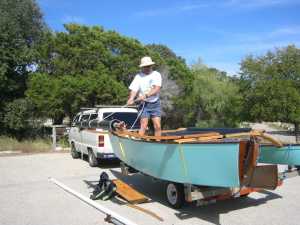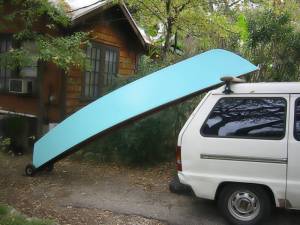|
Flaquita (Spanish for skinny little girl), was designed and built to be a lightweight, car toppable, fast, safe sailboat that can be paddled, sailed or motored. I looked all over for plans for a boat that was similar to this. I found none. I would have been happy to purchase some plans. It’s a heck of a lot easier building a boat with plans, rather than having to design from scratch. I wanted a boat that I could strap on top of my car, or haul on a small trailer, and travel to far away shores. Once I got there, I wanted a boat that could be unloaded and launched by one person. And could be launched without using a boat ramp, if none were available. I had built a sailing dinghy before. It was a Bolger design Cartopper. I cartopped it from Texas to the Pacific Northwest as far north as Desolation Sound British Columbia. I sailed it in the Florida Keys. I traveled as far south as Rio Dulce, Guatemala. It is a terrific little boat, but it has some serious limitations. It sails great. It rows great. But with its rounded bottom, it's a dog under power. It also has quite low freeboard. That, combined with the lack of a self-bailing cockpit, made it less than safe in rough water. It would never sink, but if turned over in deep water, righting it and getting back in and sailing away seems improbable. I wanted an improved boat. I wanted a boat that was:
These goals made me look at multihulls. I had seen dugout canoes on the Rio Dulce fitted with outboards that were quite fast. Why not design a long, skinny hull with an outrigger and make it a real sailboat that was capable of good speed under power also. I saw photos of traditional Polynesian outrigger canoes. I liked the design. But car topping one and setting it up to sail with all that lashing to hold the outriggers on looked too time consuming. I wanted a boat easy and quick to set up, with no tools.
Click
here to see the rest of Flaquita |












